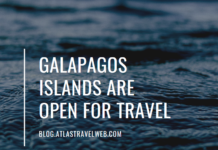Also known as the enchanted isles, the Galapagos are a naturalists dream. Cut off from human influences for millions of years, the resident population of animals have not developed a fear of man like their mainland cousins. The result is a truly spectacular wildlife-viewing experience. With iguanas, albatrosses, seals, blue footed boobies and giant tortoises all approaching viewers quizzically rather than running way, you are guaranteed an excellent trip. Add to this some beautiful beaches, great snorkeling and a couple of good hikes, and this is like no other cruise you will ever go on.
There is never a bad time to visit the Galapagos. The peak season lasts from mid-June through early September, and from mid-December through mid-January. The national park limits the number of visitors to each island, so the Galapagos will never feel crowded.
December through May – During this time of year, the water and the air are warmer, but this is also the rainy season. It drizzles almost daily for a short period of time. Ironically, this is also the sunniest time of year. The end of December and the beginning of January is still the high season, so expect more visitors than during the rest of the year.
Because the water is warm, the idea of swimming and snorkeling is enticing. On the flip side, there aren’t as many fish to see as later in the year. This is also the breeding season for land birds, so it’s a good opportunity to watch some unusual mating rituals. If you’re into turtles, this is best time of year to come; you can watch sea turtles nesting on the beach, and from March through May, you can often see the land tortoises wandering around the lowland areas of the islands as they make their way down from the highlands in search of a mate. Sea lions also mate in the rainy season — it’s entertaining to watch as the males fight it out for the females. Around March and April, you’ll see the adorable newborn pups crawling around the islands.
 June through November – From June through November, the Humboldt Current makes it way up to the Galapagos from the southern end of South America. The current brings cold water and cold weather, but it also brings water rich in nutrients and plankton, which attracts fish and birds. During this season there always seem to be clouds in the air, but it rarely rains. Conditions are windier during this period.
June through November – From June through November, the Humboldt Current makes it way up to the Galapagos from the southern end of South America. The current brings cold water and cold weather, but it also brings water rich in nutrients and plankton, which attracts fish and birds. During this season there always seem to be clouds in the air, but it rarely rains. Conditions are windier during this period.
Experienced divers claim that this is the best time of year to visit the Galapagos. Because there are more fish in the sea at this time of year, there are also more seabirds searching for these fish. Albatrosses arrive on Espanola in June and stay until December. Penguins also like the cold water and abundance of fish, so you’re more likely to see them here during this season. On Genovesa, the elusive owls mate in June and July, and you have the best chance of spotting one during this time. Blue-footed boobies also mate during this time of year, so it won’t be difficult to witness their beautiful mating ritual known as the “sky point.”








